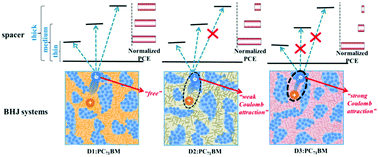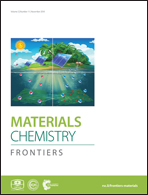Effects of different types of unsymmetrical squaraines on the material properties and Coulomb interactions in organic photovoltaic devices†
Abstract
Three unsymmetrical squaraine (USQ) dyes bearing different molecular skeletons were employed as donor materials in bulk-heterojunction (BHJ) organic photovoltaics (OPVs). The different molecular skeleton types of the USQs have an influence on their solid-state packing modes, optical properties, frontier orbital energy levels, carrier mobility and photovoltaic performance. More importantly, they also induce distinct differences in the strength of Coulomb interactions between the charge pairs in the USQ and fullerene phases. Through single crystal analysis, film morphology characterization and device architecture investigation with varying thicknesses of a bathocuproine (BCP) layer, it is found: firstly, the photovoltaic performances of the three USQ:PC71BM systems show different sensitivity to different BCP thickness, which can indirectly reflect that Coulomb attractions exist between the USQ phase and electrons in the PC71BM phase; secondly, a low electron mobility (1–2 × 10−4 cm2 V−1 s−1) in USQ : PC71BM (1 : 3) blend films may be attributed to the combination of well-mixed morphologies and strong Coulomb interactions; and thirdly, the USQ structures can affect the intensity of Coulomb attractions between the USQ phase and electrons in the PC71BM phase, and the influence can be large enough to not consider the morphology effect in some cases.



 Please wait while we load your content...
Please wait while we load your content...